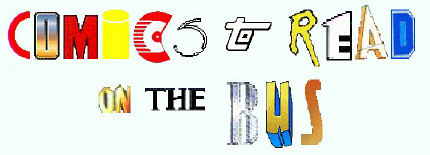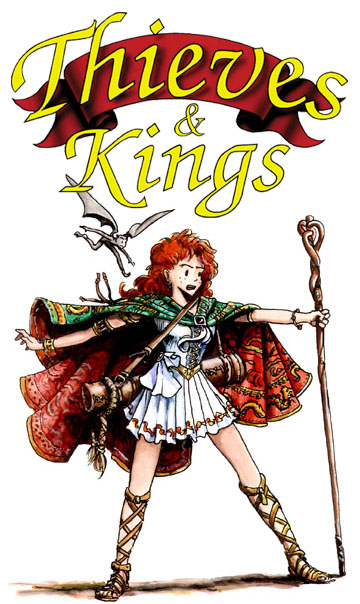

For one reason or
another, I have chosen not to hold a driver's licence. As
a result of this choice, I ride the bus. Since I work about
an hour away from where I live, I ride the bus a lot. Every
day. For those of you in similar situations, you know that
the bus is generally full of loud people, smelly people, dirty
people and annoying people. On an especially good day, I
have even found the bus full of loud, smelly, dirty, annoying
people, and that my friends is no treat at all.
However, riding the bus also provides one with
a great opportunity to catch up on my reading. I don't get
a lot of time otherwise, so I use that time to lose myself for
the duration of the ride in some fine literature of my choosing.
Most frequently, my choice of reading material is comic books,
and that creates an interesting situation. Working in a
professional environment as I do, I am often surrounded by other
professional people when I ride the bus daily. And while the opinions
of most of them do not mean much more than last Tuesday's leftovers,
I am nevertheless conscious of my choice of entertainment as it
might be perceived by those around me. What do they think,
I wonder, of the comics they see me reading on the bus each day?
(Assuming that they do think anything of it!)
This musing led me to an interesting idea:
if, one day, I found myself in the position of having to defend
my choice of reading material to an unquisitive fellow commuter,
which items on my reading list would be worth defending?
Perhaps reading comics on the bus could be a valuable indicator
of the quality of a book, with the main criteria being my own
willingness to defend that material if I had to. Certainly,
something like Art Speigelman's "Maus" would rate a
strong defense, and might not even need one, while the latest
X-clone or Rob Liefeld book would rate very little if anything
in the way of a justification. So, the conclusion is that
some comics are "comics to read on the bus",
and some are not. On this page I intend to review, critique,
or showcase those comics I think are worth reading on the bus,
and every now and them I might present one or two that I think
are not. If you have any suggestions for candidates, I would
like to hear about them. I would have to read the books
myself, of course, but if I find them and I like them, I may feature
them here.
 "Thieves & Kings"
by Mark Oakley (aka M'Oak)
"Thieves & Kings"
by Mark Oakley (aka M'Oak)
"Thieves & Kings" is a comic book that should not work. In just about every way, it breaks the traditional rules of comic books. The writing is wordy, often going from simple comic dialog to long blocks of pure text that span several pages. The art (shockingly, in black and white, with no fancy digital coloring or special effects!) is loose and sketchy, cluttered and background heavy, while the characters are drawn in a simple (some might say crude) cartoon style (check out the pupils on the lass to the left!). The story is long and detailled, and to actually follow it requires reading the whole thing; there's no "filler" issues to ease a new reader into the series...it's all connected. There's not a superhero in sight, nor ultra-violent antiheroes, nor busty babes, nor entirely loathsome villains. And perhaps most damningly of all, it is an independant....a Canadian independant!....publication. It's published and distributed by some guy out of his own operation, with no staff of editors, marketing gurus, or vice-presidents. There's no big name artists or writers, no enhanced or nude, alternate edition covers. Hell...it's never even been published by Image! I mean, how could it possibly work?
All that being said, "Thieves & Kings" is about as close to flawless as a comic book can get.
Look, and I mean really LOOK, at the image to the left. Look at the detail, at the subtlety of the color, and the character that expresses itself in every carefully delineated line. Yet, the art is approachable, without the daunting hard-edged lines of many of the "hot" artists. This is an interesting character, that the reader can feel drawn to and want to learn about. What is that grey thing hovering over her shoulder? What is that staff she's holding, and what is that thing slung over her shoulder? Interesting! And that's just a cover!
The writing may be wordy, but the language is such that it draws you in and carries you along; before you know it, those wordy pages are flying by in a rush of story and sparkling words. For example, try this:
"Autumn, incidentally, is my favorite season of the year. While I type this out, the Fall is happening right outside my window. Cool and bright, leaves turned cristpy cling to my big sweater when I walk along the train tracks which cut an East and West swath of tangled wilderness a short walk from my house...The train company put up fences to stop people from hiking through the tall grass and trees which hide from the rest of the metropolis two sets of freight tracks and a scruffy dirt road. -Something about keeping people from getting hit by trains, I'm told. And from launching lawsuits. Phooey, and fair enough, I say. I think it's important for people to live side by side with impassive dangers of the sort. Like rivers and climbing apparatuses in school yards which knock out a couple of teeth every year. Two hundred kids learn more about safety from one broken collar bone than they do from a year's worth of boring tutorials. - Not that teaching is in any way unnecessary, but I know that most of what I have learned aboaut life was done simply by watching the odd disaster or two unfold around me. Thankfully, for as long as there have been walls surrounding the hidden places, people have been cutting and bending the heavy guage wire of chain link fences into treacherous, rusty holes through which people can duck if they dare. Life is on the other side, amond the weeds and the rails."
See what I mean? And that's just from one of his introductions! In its writing, Thieves & Kings effortlessly straddles the barrier between "comics" and high literature that the Art Spiegelman's and Francois Mouly's of the genre work themselves into an arthouse tizzy over. It is simply good reading, well written, and in my opinion, that's the best any story can achieve.
Artistically, Oakley is a world builder; I would dare to say as much as Tolkien was with his words. Oakley does not just use conventional images or stereotypes to fill a background or compose a layout; his environment is unique and consistent with his story. The details he provides in every panel, from his rich splash pages to his talking head shots, invoke a world that is as much a part of the story as the characters. Those characters, simply drawn though they may be, move and react in natural ways to create a believability that goes beyond the over-inked action figure poses that seem to be an industry standard. They recall Scott McCloud's argument from "Understanding Comics" that simple cartoon faces allow for a more universal appeal through allowing us to project more of our own imaginations onto them. Yet there is no boring sameness to them, despite their simplicity; each character has clear defining traits and attitudes that brings them to life as much through their actions as their words. The good ones have their interesting flaws, and the bad ones are never entirely bad, nor guaranteed to stay the way they are. Personalities and allegiances shift as characters develop and grow over the course of the story. These are not just characters, they are people.
Oakley restricts his color to his covers, but those, as you can see above, are a treat. These are the work of a painter, with subtleties of tone and light that need to be experienced up close to be truly appreciated. Studying these covers, I think more of the Romantic painters like Waterhouse than I do of anybody in the comics industry (except maybe Barry Windsor-Smith).
As for it being an independant publisher, Oakley's company I Box Publishing does not seem to be bothered by this. Nowhere in his work do I see an indication that he is not satisfied with what he has built for himself, and consequently, no indication that he wants to temper his work to appeal to the "mass market". "Thieves & Kings" is what it is, and makes no apologies for that. In fact, "Thieves & Kings" succeeds exactly because it is not just a piece of hack work, not a book designed for the lowest common denominator, but a true work of art, in the sense that it is the artist's personal vision and is true to itself on all levels.
The end result is that "Thieves & Kings" works. Each element, in the absence of the others, would possibly make the book a failure. In conjunction, they achieve a sort of harmony that makes for a captivating story and good comics. If you're looking for a good read in the comic shop, pick up "Thieves & Kings"; I think that once you get in, you won't want to leave.
"Thieves & Kings" is available from most comics shops, and is listed in Previews magazine monthly under I Box Publishing. You can also order the book online from Mark Oakley at www.iboxpublishing.com. While you're there, check out some of Oakley's editorials' they're good reading as well. There are at least 36 issues out, and four collections to date, with a fifth on the way. Hurry up Mark....the suspense is killing me.
Visit the "Comics to Read on the Bus" Archives here.